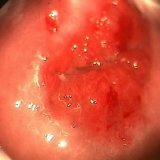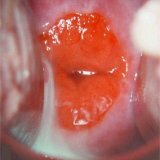Menarche
 Menarche is the age of arrival of the first menstruation in a girl who is an important criterion for evaluating correct sexual development. Every young female organism, like all the structural and physiological changes that take place in it, is unique enough. The pace of puberty does not occur in all girls symmetrically, because they are influenced by a variety of factors. Therefore, menarche in girls has a wide range of norms: the majority of the first monthly occur at 11 to 13 years, but this event can be shifted within 10 to 15 years.
Menarche is the age of arrival of the first menstruation in a girl who is an important criterion for evaluating correct sexual development. Every young female organism, like all the structural and physiological changes that take place in it, is unique enough. The pace of puberty does not occur in all girls symmetrically, because they are influenced by a variety of factors. Therefore, menarche in girls has a wide range of norms: the majority of the first monthly occur at 11 to 13 years, but this event can be shifted within 10 to 15 years.
Menarche is rightly associated with one of the most important criteria for puberty. The first menstruation means that the girls' ovaries gradually become "adults", that is, they begin to actively synthesize the sex hormones involved in the formation of the menstrual cycle.
Period of puberty( puberty) begins at the age of 8 and, if it proceeds physiologically, is completed by the age of 16.During this time period the formation of the reproductive system takes place and the physical development of the future woman ends. The body actively grows in length, the growth zones in the tubular bones are closed, the "female" type of figure is formed due to the specific arrangement of the muscular and fatty tissues.
According to the consistent structural and functional changes in the ovaries and the regulatory centers of the brain( pituitary-hypothalamus), puberty occurs in three stages, or periods:
- The first, prep( pre-pubertal) period. It takes 8 to 9 years of age. The organism begins to synthesize sex hormones randomly and occasionally, but the level of estrogen is still very low.
There is an intensive growth of the body in length as a "growth jump", and the figure of the girl acquires feminine features: the contour of the thighs is rounded, the "female" pelvis begins to form, and the vaginal epithelium ceases to be single-layered, increasing the number of layers due to the appearance of intermediate cells, of whichsubsequently, new epithelial structures will be formed.
- The second period. Its beginning coincides with the onset of puberty proper, or puberty. It lasts several years and is conditionally divided into two main stages, or phases. In the beginning( phase one) of the pubertal period( 10-13 years), the changes are characterized by the appearance of daily cyclic hormonal oscillations, as well as increased production of FSH and LH by the pituitary gland, which in turn stimulate the ovaries, therefore they synthesize sex hormones intensely.
Mammary glands are enlarged in volume, on the pubis, hair appears. The vaginal microflora also changes: lactobacilli appear in its composition.
It is this period that ends with the first menstruation( menarche).In time, it coincides with the end of the intense growth of the body in length.
- The third period is the second, final, pubertal phase( 14 - 16 years).Hormonal secretion becomes cyclical, the ovaries begin to function according to the phases of the menstrual cycle, and high levels of FSH and LH provide ovulation.
Mammary glands are finally formed, the development of the pelvis and "female" hair is completed, the body ceases to grow intensively in length.
First, ovulatory cycles can be unstable, but their irregularity can not save the girl from an early pregnancy. At this age, it is possible in 25% of girls who have a random ovulation, so it is extremely important for them to have a trusting relationship with adult close relatives( mother, grandmother, sister) who could tell the girl about unwanted intimate relationships at such a young age and their negative consequences.despite the external features of women and the presence of menstruation, the body during this period is still partially "childish" and is not ready to bear pregnancy and childbirth.
The culmination of the puberty period is the first complete ovulation. However, it does not mean complete puberty. By sexual maturity is meant not only the accomplished sexual maturation, but also the development of the whole organism as a whole, when it is fully ready for the realization of the most important mission of the woman - the procreation. The period of sexual maturity starts after 16 and ends at 40 years.
The untimely onset of menarche in girls can have quite innocuous causes, but more often it signals problems of puberty.
The absence of menarche after 16 years is a serious pathological symptom, indicating a lack of sexual development.
The onset of menarche
The appearance of the first months is preceded by a period of complex morphological changes in the structure and, accordingly, the functioning of the genital organs. The ovaries of small girls are similar to thin spindle-shaped formations containing unripe follicles, they are formed during the newborn period and are in a static state with no signs of maturation. Underdeveloped follicles already synthesize the follicular hormone( estrogen), but its quantity is sufficient only for the right, corresponding to the age norm, the formation of the genitals. More mature follicles begin to appear in the ovaries shortly before the menarche.
Fallopian tubes also change as the girl grows up. They become wider and longer, increase in volume and acquire a sinuous shape. The inner mucous layer lining the lumen of the fallopian tubes also becomes more bulky due to growth and the formation of numerous folds( labyrinth of the tube).In the same period, the upper layer of mucous cells is gradually transformed into ciliary( ciliated) epithelium, named so because of the presence of thin villi( cilia) on the cell membrane. After the end of puberty, they will be able to move in a certain direction( "flicker") to move the fertilized egg toward the uterus.
The uterus, also preparing for menarche, also changes. In children, it looks like a small condensation of elongated shape without a clear differentiation into divisions. Most of the baby's uterus is the neck( 2/3).When the menarche period comes, the uterus body is twice as big as the neck. The endometrium also changes: the proliferation( proliferation) of the glands begins and the differential development of the basal and functional layers begins. The thickness of the endometrium is already 2 mm.
Intensive structural changes occur in the girl's vaginal mucosa. The vagina grows in width and length, vaults and folds are formed. Since the ovaries are already beginning to secrete estrogens, the structure of the mucous layer lining the vaginal cavity also changes - it becomes multilayered. Such epithelium with the help of follicular ovarian hormone is able to accumulate glycogen - the main source of nutrition for lactobacilli. Thus, the "adult" vaginal microenvironment is formed: the stems of the Dederlein( lactobacilli), which extract lactic acid from glycogen, and thus control the level of local acidity( pH), appear in the vagina. The epithelium of the baby's vagina is devoid of hormonal( estrogen) influence, therefore glycogen does not contain, and the acidity is maintained neutral or slightly alkaline.
Menarche period implies normal acidity in the range 4.5 - 5.0.The number of vaginal secretions in the menarche period and shortly before its beginning increases, so in the asymptomatic appearance of light, mild secretions without odor and pathological impurities in a girl older than ten years, we can assume an early first menstruation.
External genitalia in anticipation of menarche accumulate adipose tissue, increase and acquire hairline. The increasing function of the sebaceous glands of the labia minora provokes an increase in the volume of the secret secreted by them.
Psycho-emotional sphere and vegetative-vascular system on the eve of menarche also signal about forthcoming changes. The general state of health changes, the girl becomes more emotionally labile, can complain of dizziness, fatigue, short mild pains in the projection of the uterus.
Age of onset menarche even with its significant allowable time range has an important diagnostic value. If the first menstruation happens too early or occurs after the prescribed 16 years, you should think about premature puberty or its delay.
Early menarche is associated with a premature "inclusion" of the hormonal function of the ovaries, so it is almost always accompanied by premature puberty: an increase in the mammary glands, the appearance of external genitalia in girls under the age of nine. Such hormonal dysfunction can be a consequence of the pathology of the central nervous system( pituitary-hypothalamus) or hormone-producing ovarian tumors.
Much more common later in menarche. And, quite often it happens not because of serious problems( although such also occur) with health. The most popular reason for delaying menstrual function in modern girls is weight loss. In the absence of hormonal function of the ovaries, the children's body "extracts" estrogens from adipose tissue to maintain normal mechanisms of puberty, normally it should be at least 17% of a healthy girl. Excessive leanness interferes with the given physiological process, therefore there is a hormonal deficiency, and monthly in the put age period do not come. As a rule, if the reasons for delaying menarche are not timely eliminated, the reproductive system may remain underdeveloped( infantile), which will subsequently affect the reproductive function.
Expressed emotional experiences and stresses can change the time of the onset of menarche. Stress calls for a spasm of cerebral vessels that feed the menstrual function of the organs - the pituitary gland and the hypothalamus. As a result, these zones do not eat well and begin to work with interruptions.
Later menarche also can signal for more serious reasons: ovarian hypofunction, malformation of the genes, endocrine pathologies.
Later or early menarche is sometimes determined genetically, when the first menstruation in terms of time corresponds to that of the mother of the girl. Typically, no pathology, this situation does not imply.
The absence of menarche, undeveloped mammary glands and unformed genital and axillary hairline in girls after 16 years indicate the developmental defects of gonads associated with severe endocrine pathology.
Signs of menarche
It should be noted that the age of onset menarche is not considered a unanimous criterion of sexual development. It is important that the men not only come on time, but also comply with the accepted physiological norms. Menstrual function after menarche at first has its own peculiarities, therefore some deviations from the norm are permissible.
Only 20% of girls have a monthly period immediately after menrach become regular. As a rule, in the first 1-1,5 years they come with delays and have different duration. Also, menstruation may be unequally abundant. If the girl is healthy, and the process of becoming a hormonal function proceeds normally, the monthly ones are self-regulating after the adaptation period has passed.
In order to be guided by the changes that are taking place, from the appearance of the menarche the girl must learn how to manage the individual menstrual calendar and mark the first day of the next menstruation, as well as all the attendant unusual symptoms. Thus, she recognizes her menstrual cycle( it is equal to the number of days from one to another marked date) and its important characteristics: duration, volume of blood loss.
Most women get menstruation once every 28 days. Intermenstrual interval in 25-35 days is not considered pathology. The number of "abundant" days does not exceed three days, and the menstruation itself should not last less than three and longer than seven days. A daily change of four or less pads indicates normal blood loss.
If the menarche is not established after menarche for one and a half years, hormonal function of the ovaries should be investigated.



